View in other NatureServe Network Field Guides
NatureServe
Montana
Utah
Wyoming
Idaho
Wisconsin
British Columbia
South Carolina
Yukon
California
New York
Northern Montane Shrew - Sorex obscurus
Other Names:
Dusky or Montane Shrew,
Sorex monticolus
Native Species
Global Rank:
G5
State Rank:
S5
(see State Rank Reason below)
Agency Status
USFWS:
USFS:
BLM:
External Links
State Rank Reason (see State Rank above)
Species is relatively common within suitable habitat and widely distributed across portions of the state
General Description
Pacific coast: pelage gray brown; median tine on anteriomedial edge of I1 usually large and robust; tail indistinctly bicolored; 5 or 6 pairs of friction pads on second to fourth digits of hind feet; level of pigmentation above level of median tine on I1; body size small to medium; U5 triangular, body of U1s not touching, P4 overlapping U5; zygomatic process of maxillary pointed (Carraway 1990).
Diagnostic Characteristics
See Carraway (1995) for a key to western North American soricids based primarily on dentaries.
Species Range
Montana Range
Range Descriptions
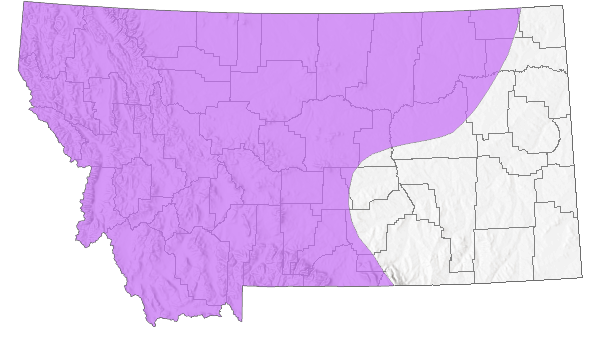
 Native
Native
Observations in Montana Natural Heritage Program Database
Number of Observations: 349
(Click on the following maps and charts to see full sized version)
Map Help and Descriptions
Relative Density
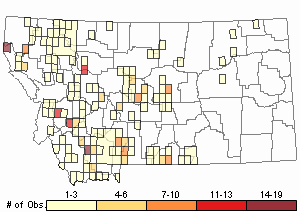
Recency
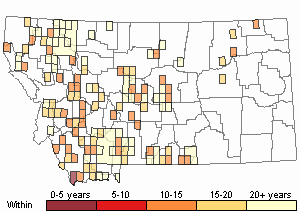
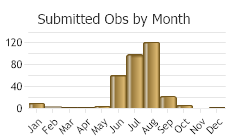
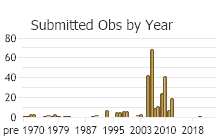
 (Observations spanning multiple months or years are excluded from time charts)
(Observations spanning multiple months or years are excluded from time charts)
Migration
Non-migratory.
Habitat
In western Montana, high altitude spruce-fir forest, alpine tundra. Also as low as 3000 ft. in mid-altitude forests. Occurs along streams and rivers east of Continental Divide and in isolated mountain ranges in central Montana (Hennings and Hoffmann 1977).
Ecological Systems Associated with this Species
- Details on Creation and Suggested Uses and Limitations
How Associations Were Made
We associated the use and habitat quality (common or occasional) of each of the 82 ecological systems mapped in Montana for
vertebrate animal species that regularly breed, overwinter, or migrate through the state by:
- Using personal observations and reviewing literature that summarize the breeding, overwintering, or migratory habitat requirements of each species (Dobkin 1992, Hart et al. 1998, Hutto and Young 1999, Maxell 2000, Foresman 2012, Adams 2003, and Werner et al. 2004);
- Evaluating structural characteristics and distribution of each ecological system relative to the species' range and habitat requirements;
- Examining the observation records for each species in the state-wide point observation database associated with each ecological system;
- Calculating the percentage of observations associated with each ecological system relative to the percent of Montana covered by each ecological system to get a measure of "observations versus availability of habitat".
Species that breed in Montana were only evaluated for breeding habitat use, species that only overwinter in Montana were only evaluated for overwintering habitat use, and species that only migrate through Montana were only evaluated for migratory habitat use.
In general, species were listed as associated with an ecological system if structural characteristics of used habitat documented in the literature were present in the ecological system or large numbers of point observations were associated with the ecological system.
However, species were not listed as associated with an ecological system if there was no support in the literature for use of structural characteristics in an ecological system,
even if point observations were associated with that system.
Common versus occasional association with an ecological system was assigned based on the degree to which the structural characteristics of an ecological system matched the preferred structural habitat characteristics for each species as represented in scientific literature.
The percentage of observations associated with each ecological system relative to the percent of Montana covered by each ecological system was also used to guide assignment of common versus occasional association.
If you have any questions or comments on species associations with ecological systems, please contact the Montana Natural Heritage Program's Senior Zoologist.
Suggested Uses and Limitations
Species associations with ecological systems should be used to generate potential lists of species that may occupy broader landscapes for the purposes of landscape-level planning.
These potential lists of species should not be used in place of documented occurrences of species (this information can be requested at:
mtnhp.mt.gov/requests) or systematic surveys for species and evaluations of habitat at a local site level by trained biologists.
Users of this information should be aware that the land cover data used to generate species associations is based on imagery from the late 1990s and early 2000s and was only intended to be used at broader landscape scales.
Land cover mapping accuracy is particularly problematic when the systems occur as small patches or where the land cover types have been altered over the past decade.
Thus, particular caution should be used when using the associations in assessments of smaller areas (e.g., evaluations of public land survey sections).
Finally, although a species may be associated with a particular ecological system within its known geographic range, portions of that ecological system may occur outside of the species' known geographic range.
Literature Cited
- Adams, R.A. 2003. Bats of the Rocky Mountain West; natural history, ecology, and conservation. Boulder, CO: University Press of Colorado. 289 p.
- Dobkin, D. S. 1992. Neotropical migrant land birds in the Northern Rockies and Great Plains. USDA Forest Service, Northern Region. Publication No. R1-93-34. Missoula, MT.
- Foresman, K.R. 2012. Mammals of Montana. Second edition. Mountain Press Publishing, Missoula, Montana. 429 pp.
- Hart, M.M., W.A. Williams, P.C. Thornton, K.P. McLaughlin, C.M. Tobalske, B.A. Maxell, D.P. Hendricks, C.R. Peterson, and R.L. Redmond. 1998. Montana atlas of terrestrial vertebrates. Montana Cooperative Wildlife Research Unit, University of Montana, Missoula, MT. 1302 p.
- Hutto, R.L. and J.S. Young. 1999. Habitat relationships of landbirds in the Northern Region, USDA Forest Service, Rocky Mountain Research Station RMRS-GTR-32. 72 p.
- Maxell, B.A. 2000. Management of Montana's amphibians: a review of factors that may present a risk to population viability and accounts on the identification, distribution, taxonomy, habitat use, natural history, and the status and conservation of individual species. Report to U.S. Forest Service Region 1. Missoula, MT: Wildlife Biology Program, University of Montana. 161 p.
- Werner, J.K., B.A. Maxell, P. Hendricks, and D. Flath. 2004. Amphibians and reptiles of Montana. Missoula, MT: Mountain Press Publishing Company. 262 p.
- Commonly Associated with these Ecological Systems
Alpine Systems
Forest and Woodland Systems
Grassland Systems
Human Land Use
Recently Disturbed or Modified
Shrubland, Steppe and Savanna Systems
Wetland and Riparian Systems
- Occasionally Associated with these Ecological Systems
Alpine Systems
Grassland Systems
Human Land Use
Sparse and Barren Systems
Food Habits
Similar to other long-tailed shrews: eats mostly invertebrates (van Zyll de Jong 1983).
Ecology
Non-breeders territorial. Breeders apparently not territorial (van Zyll de Jong 1983).
Reproductive Characteristics
First-year animals may not be reproductively active (van Zyll de Jong 1983).
Stewardship Responsibility
References
- Literature Cited AboveLegend:
 View Online Publication
View Online Publication Carraway, L.N. 1990. A morphologic and morphometric analysis of the 'Sorex vagrans species complex' in the Pacific coast region. Texas Tech Univ. Mus. Spec. Publ. (32): 1-76.
Carraway, L.N. 1990. A morphologic and morphometric analysis of the 'Sorex vagrans species complex' in the Pacific coast region. Texas Tech Univ. Mus. Spec. Publ. (32): 1-76. Carraway, L.N. 1995. A key to recent Soricidae of the western United States and Canada based primarily on dentaries. Occasional Papers of the Natural History Museum, University of Kansas (175):1-49.
Carraway, L.N. 1995. A key to recent Soricidae of the western United States and Canada based primarily on dentaries. Occasional Papers of the Natural History Museum, University of Kansas (175):1-49. Hennings, D. and R.S. Hoffmann. 1977. A review of the taxonomy of the Sorex vagrans species complex from western North America. Occasional Papers of the Museum of Natural History, the University of Kansas. 68: 1-35.
Hennings, D. and R.S. Hoffmann. 1977. A review of the taxonomy of the Sorex vagrans species complex from western North America. Occasional Papers of the Museum of Natural History, the University of Kansas. 68: 1-35. Van Zyll de Jong, C.G. 1983. Handbook of Canadian mammals. 1. Marsupials and insectivores. National Museum of Natural Sciences, National Museums of Canada, Ottawa, Canada. 210 pp.
Van Zyll de Jong, C.G. 1983. Handbook of Canadian mammals. 1. Marsupials and insectivores. National Museum of Natural Sciences, National Museums of Canada, Ottawa, Canada. 210 pp.
- Additional ReferencesLegend:
 View Online Publication
View Online Publication
Do you know of a citation we're missing?
- Web Search Engines for Articles on "Northern Montane Shrew"
- Additional Sources of Information Related to "Mammals"





